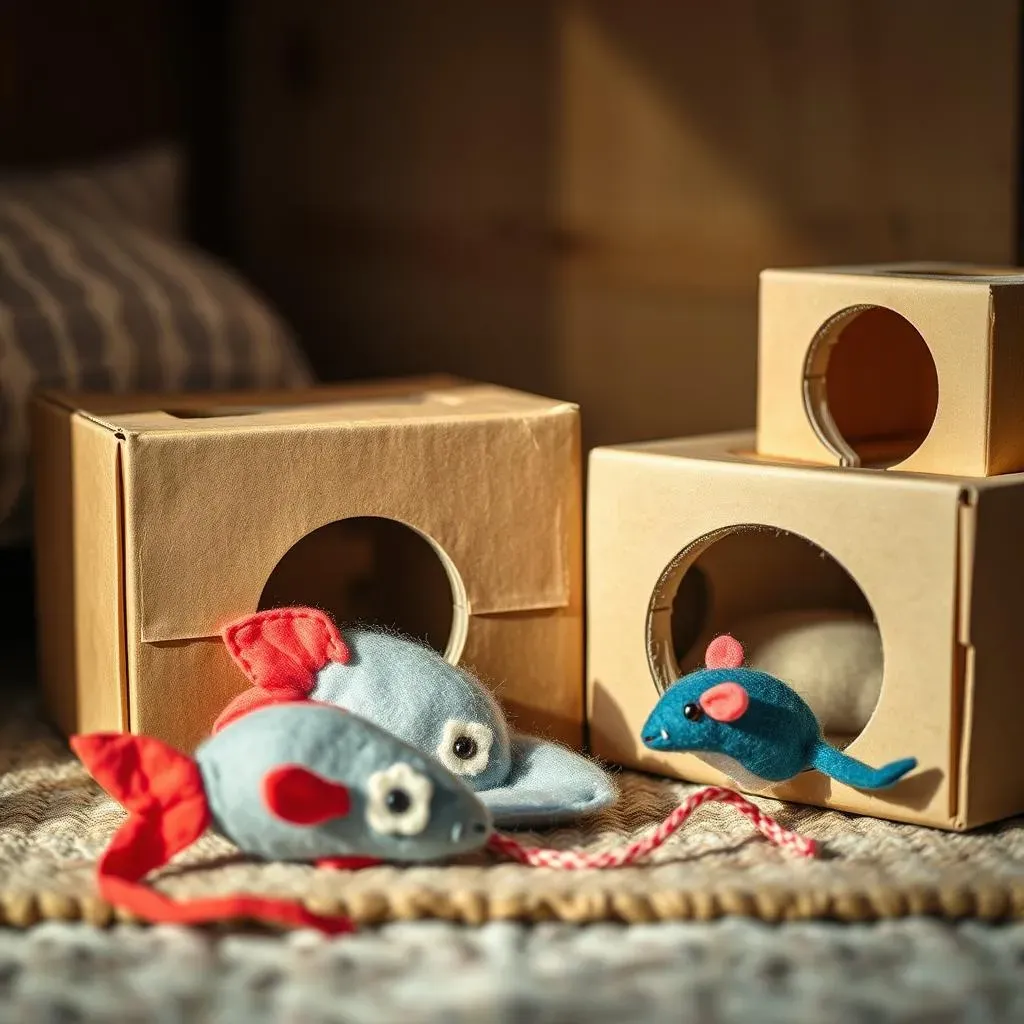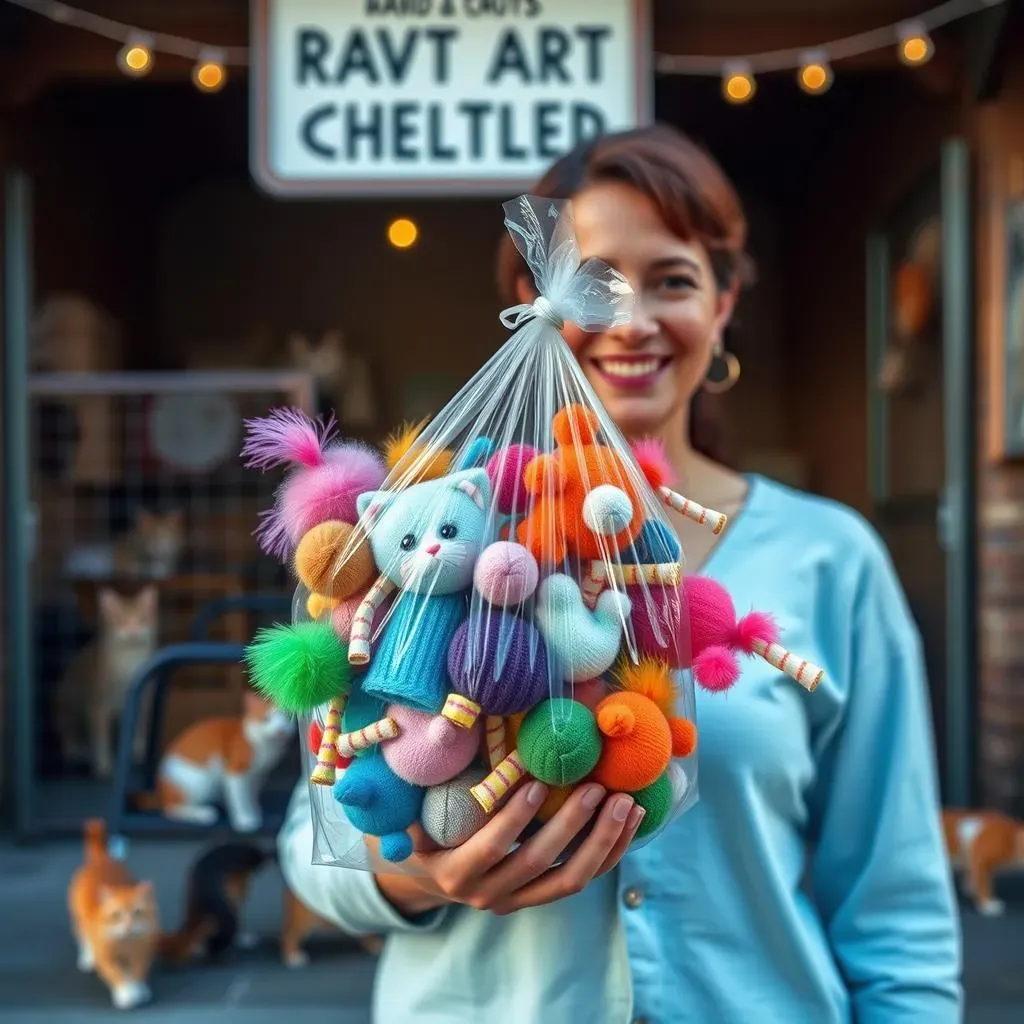Table of Contents
Ever wished you could do more to help shelter cats? Many shelters struggle with limited resources, and one simple way to make a huge difference is by creating homemade cat toys! This article is your guide to crafting fun, safe, and engaging homemade cat toys for shelters. We'll explore a range of easy-to-make options using readily available materials, ensuring the toys are both stimulating and durable. You'll discover creative ideas, learn about safety considerations, and get practical tips for donating your creations. From simple cardboard creations to more elaborate felt toys, we've got something for every skill level. Get ready to unleash your creativity and help improve the lives of shelter cats with homemade cat toys for shelters – it's a rewarding experience that makes a real impact!
Easy Homemade Cat Toys for Shelters

Easy Homemade Cat Toys for Shelters
Cardboard Creations: Simple and Safe
Let's start with the easiest: cardboard! Toilet paper rolls are a goldmine for feline fun. Simply leave them as is for a simple tunnel, or get creative. Cut them into rings, stuff them with catnip (if the shelter allows), or decorate them with non-toxic paint. Think outside the box (pun intended!) and use cereal boxes, too! Cut holes for peek-a-boo fun, or create a miniature maze. Remember to remove any staples or tape that could be a hazard.
Cardboard is a fantastic, readily available material. It's also easily disposable, which is a huge plus for shelters. The best part? It's virtually free!
Toy Type | Materials | Instructions |
|---|---|---|
Toilet Paper Roll Tunnel | Toilet paper rolls | Leave as is or decorate |
Cardboard Maze | Cereal box | Cut out various sized holes |
Sock Puppets: A Cozy Companion
Old socks? Don't throw them away! Stuff them with soft materials like cotton balls or even old fabric scraps. Tie the top off securely to prevent your furry friends from getting tangled in the stuffing. You can even add a bit of catnip for extra appeal (again, check with the shelter first). These are incredibly soft and comforting, perfect for cuddling and play. They're also easy to wash if they get a little messy.
Remember to use socks without buttons or small, detachable parts that could pose a choking hazard. A simple knot is all you need to secure the stuffing.
- Gather old socks (clean!)
- Stuff with soft, safe materials
- Tie off securely
- Add catnip (optional)
Yarn Balls: A Classic Cat Toy
Yarn balls are a classic for a reason! Cats love to bat and chase them. Simply wind some yarn around your fingers, creating a loose ball. Secure the end with a knot. You can make these as big or small as you like. For extra fun, add a bell inside. Again, always make sure the yarn is securely fastened to prevent any choking hazards. Don't use anything too thin or flimsy, as it may unravel easily.
This is a simple project, perfect for beginners. It's a great way to use up leftover yarn scraps.
"A cat's play is its life's work." - Unknown
Safe and Engaging Homemade Cat Toys for Shelters

Safe and Engaging Homemade Cat Toys for Shelters
Fabric Fun: Felt Fish and Fleece Mice
Let's move on to fabric toys! Felt is a great choice because it's durable, easy to sew (or even glue!), and comes in tons of fun colors. Cut out simple shapes like fish or mice, and sew them together, leaving a small opening to stuff with catnip or cotton. You can even add some embroidery details for extra pizazz! Fleece is another excellent option; it's soft, cuddly, and easy to work with. Try making simple mice by cutting out two identical shapes, sewing them together, and adding a tail. These are super soft and are great for those cats who like to snuggle.
Remember to use strong thread and secure all seams well to prevent your feline friends from getting at the stuffing. Always avoid small, detachable parts that could pose a choking hazard. A simple running stitch is perfect for beginners.
- Choose durable fabrics like felt or fleece
- Cut out simple shapes (fish, mice, etc.)
- Sew or glue pieces together, leaving an opening for stuffing
- Stuff with catnip or cotton
- Securely close the opening
Interactive Enrichment: Puzzle Feeders
Cats love to hunt and forage! Puzzle feeders offer a fantastic way to engage their natural instincts while providing mental stimulation. You can create a simple puzzle feeder by poking holes in a cardboard box or using an empty egg carton. Hide small treats inside, and let the cats work to get them out. This is a particularly great option for shelters as it helps to keep cats entertained and prevents boredom, which can lead to destructive behaviours. For a more advanced puzzle, you can use PVC pipes, but make sure all edges are smooth and there are no sharp bits.
Remember to supervise your cats while they're using puzzle feeders, and make sure the treats are age-appropriate and aren't too small to pose a choking hazard. Start with easier puzzles and gradually increase the difficulty as your cat gets better at them.
Puzzle Type | Materials | Difficulty |
|---|---|---|
Cardboard Box Puzzle | Cardboard box, treats | Easy |
Egg Carton Puzzle | Egg carton, treats | Easy |
PVC Pipe Puzzle (Advanced) | PVC pipe (smooth edges), treats | Hard |
Creative Homemade Cat Toys Ideas for Animal Shelters

Creative Homemade Cat Toys Ideas for Animal Shelters
Bottle Cap Fun: A Simple Sensory Experience
Let's think outside the usual cat toy box! Plastic bottle caps offer a surprisingly engaging sensory experience. Their different textures and sounds can be captivating for cats. Simply clean and thoroughly dry a bunch of bottle caps. You can leave them as they are for a simple texture toy, or you can tie them together with string to create a dangling toy. Remember to ensure there are no sharp edges. Supervise your cat while they play with bottle caps to ensure they don't ingest any.
This is a fantastic way to upcycle materials you might otherwise throw away. It's also incredibly cheap!
Toy Type | Materials | Safety Note |
|---|---|---|
Bottle Cap Texture Toy | Clean, dry bottle caps | Check for sharp edges |
Dangling Bottle Cap Toy | Clean, dry bottle caps, string | Supervise play |
Paper Bag Adventures: A Hideaway Haven
Paper bags are another fantastic, readily available material for creating homemade cat toys for shelters. Cats love to explore and hide, so a simple paper bag can provide hours of entertainment. You can leave the bag as is, or cut small holes for peek-a-boo fun. You can even add some crinkling noises by crumpling some newspaper and placing it inside. Remember to use sturdy paper bags and supervise your cat to ensure they don't ingest any paper.
This is a simple, inexpensive, and environmentally friendly option. It's also easily disposable, which is a big plus for shelters.
- Gather clean paper bags (avoid plastic bags)
- Leave as is or cut small holes
- Add crinkled newspaper for extra fun (optional)
- Supervise play
DIY Catnip Mice: A Classic with a Twist
Let's elevate the classic catnip mouse! Instead of using felt, try using old t-shirts or other soft fabrics. Cut out simple mouse shapes, sew them together, and stuff with catnip. You can get creative with the design; add buttons for eyes, or embroider whiskers. Remember to use strong thread and secure all seams well to prevent the catnip from spilling out. This is a great opportunity to upcycle old clothing and give it a new life. The soft fabric will be especially comforting for anxious cats.
Remember to always check with the shelter about their catnip policies before making catnip toys.
"The best way to find yourself is to lose yourself in the service of others." - Mahatma Gandhi
Donating Your Homemade Cat Toys to Shelters: Tips and Tricks

Donating Your Homemade Cat Toys to Shelters: Tips and Tricks
So, you've crafted a mountain of purr-fect toys – fantastic! Now, let's get them into the paws of grateful shelter cats. First, contact your local shelter. Don't just drop off a bag; call ahead! Find out what they need most – certain types of toys, materials they prefer, even if they have any allergies to consider. Some shelters may have specific guidelines for donated items, so it's always best to check in advance. This ensures your thoughtful gifts are actually useful and safe for the animals.
Presentation matters! Even if your toys are simple, a little extra care goes a long way. Keep toys clean and neatly packaged. Consider using clear plastic bags or containers so the staff can easily see what's inside. A handwritten note explaining what each toy is and how it's made adds a personal touch. It also helps staff understand the materials used, which can be crucial for cats with sensitivities.
Donation Tip | Why It Matters |
|---|---|
Contact the shelter first | To ensure your donation is needed and meets their guidelines |
Package toys neatly | For easy identification and hygiene |
Include a note | To provide information about the toys and materials |
Think beyond the toys themselves. Perhaps you could offer to help organize the toy area or even spend some time playing with the cats. Shelters are often understaffed, so any extra hands are incredibly valuable. A bit of extra time spent interacting with the animals can make a real difference in their well-being. Many shelters also appreciate donations of other supplies, such as blankets, food, or cleaning products, so consider bundling your toys with other helpful items. This demonstrates your commitment to the shelter's overall mission.
Remember, your donation isn't just about the toys; it's about showing your support for the shelter and the animals in its care. A thoughtful donation, made with care and consideration, can significantly improve the lives of shelter cats. By going the extra mile, you're not just giving a gift, you're making a tangible difference in the lives of those who need it most. So, go forth and spread the joy – one handmade cat toy at a time!
- Offer to help with other tasks at the shelter
- Consider donating other needed supplies
- Remember that your donation is a gesture of support